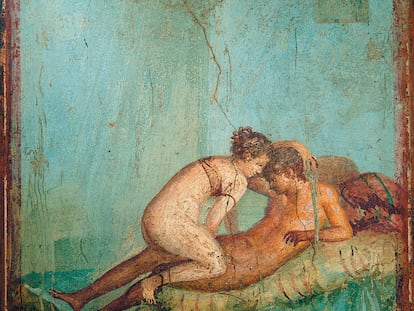Not even sex is immune to hoaxes: Tall tales about vibrators, chastity belts and inflatable dolls
Literature and film are full of sexual objects and practices that never really quite existed, even if many sources assure that they did

If you have ever read something about sexuality, you might know that the invention of vibrators responded to the need of Victorian doctors to cure female hysteria. Before that time, the story goes, doctors used to perform a manual massage in the genital area to calm symptoms that included dizziness, weakness or mood changes. Then, with the creation of the electric vibrator, the treatment became more effective — and easier on the arms of the long-suffering doctors. There is even a film about it, Hysteria (2011), which opens with the words “This story is based on true events. Really.” We must admit that the idea of doctors masturbating women in their consultation rooms and inventing the vibrator to treat them has many ingredients to succeed. Too bad it is not true.
Sex is not immune to hoaxes, and a lie repeated a thousand times becomes the truth. That is what happened with the story of the invention of the vibrator. Just like fake news usually reach more people than their rebuttals, numerous articles have echoed this story, but far fewer have bothered to publish the rectification.
The book The Technology of Orgasm: “Hysteria,” the Vibrator, and Women’s Sexual Satisfaction by Rachel P. Maines, a scientist specializing in the history of technology, was published in 2010. This is where the whole theory of the invention of vibrators to masturbate Victorian women as a medical treatment comes from. Maines justifies her theory with numerous quotes and adds the idea that the phallocentric model of sexuality made this treatment accepted because at that time it was not considered a sexual practice, as it did not involve vaginal penetration.
The book also explains that Dr. Mortimer Granville — the inventor of the vibrator — denied that he applied this form treatment on women, which the author justifies by assuring that “physicians clearly had an interest in maintaining their professional dignity.” We do not know if it was some inconsistency of this kind or the sheer eccentricity of the story what drove Hallie Lieberman and Eric Schatzberg, also historians, to focus their attention on this theory and conclude that there was no evidence to justify it. In 2018 they published A failure of academic quality control: The technology of orgasm, an article where they explained that, after carefully assessing the sources cited in the book, they had found no evidence that physicians ever used electromechanical vibrators to induce orgasms in female patients as a medical treatment. To this, Maines replied that her text was only a hypothesis that resonated among people, and that she was actually surprised that it had taken so long for someone to refute it. We rest our case.

It is true that vibrators were invented at the end of the 19th century and had a medical use: massaging certain areas of the body to relieve various ailments such as digestive problems, flatulence and even to remove wrinkles. Just not to give women orgasms. In the first decades of the 20th century, however, domestic vibrators became popular and, in the privacy of their home, some suspect that there were women who did begin to use these types of stimulations for more pleasurable purposes. As it is done today.
The fake chastity belts of the Middle Ages
The Middle Ages is a time in human history that is often depicted as barbaric. Museums with torture devices from that era are examples of this. In this context, the existence of chastity belts — panty-shaped objects made of iron that the husband placed on his wife when he had to leave home for long periods of time to ensure that she was not penetrated by anyone — fits perfectly. The chastity belt would have had a double objective: on one hand, to guarantee fidelity and, on the other, to prevent possible rape. It was also placed on daughters to guarantee their virginity.
According to José Manuel Rodríguez García, from the Department of Medieval History of the National University of Distance Education (Spain), “there is not a single material piece of evidence that chastity belts existed in that period.” That is to say, there is a lot of literary representation, but no historical references. In addition, the practical aspects of the contraption must be taken into account. Spending months or years with a heavy iron belt around the hips and pelvic area would have been very difficult, not to mention the wounds caused by the metal chafing the skin, which would probably cause infections at a time in which antibiotics did not exist.
And speaking about museums, you might have seen an alleged chastity belt from medieval times on display somewhere. The British Museum in London, for instance, had one that it removed after confirming that it was fake. According to Rodríguez García, “those chastity belts are recreations from the last two centuries. The oldest on record dates back to the first third of the 16th century.” Chastity belts, like the droit du seigneur, were conceived during the Enlightenment to imbue the Middle Ages with a dark aura.
The inflatable doll that never existed
The Borghild Project is another unconfirmed story related to sex. This is the name given to an alleged Nazi project from 1941 designed to create an inflatable doll for the German soldiers during World War II. Casualties due to sexually transmitted infections, mainly syphilis, were a risk that depleted the armies of that time. This is true; you just need to see the posters that warned soldiers of the danger of seeing prostitutes, as it was a source of contagion of venereal diseases. To avoid potential casualties, and given the sexual needs of young male combatants, it made sense (according to the mentality of the time) to create an inflatable doll that soldiers could carry in their backpacks. In a moment of need, they would just take it out and inflate it. Hygienic and easy. Supposedly, this is how inflatable dolls were created.
To round off this urban legend, details of the doll’s design have been provided. In true Aryan style, she was a 5′9″ blue-eyed blonde with large lips and breasts and an articulated head, legs and arms. The project, they say, did not materialize because a bombing destroyed the factory that produced the dolls. Beyond a website that accepts their existence and a publication in the German tabloid Bild, however, numerous sources refute the veracity of the story after not finding — again — reliable historical references.
The Borghild Project is, to say the least, an interesting story. Just like the other two. Perfect for a fun evening among friends. But they are also hoaxes, not to be taken for historical truths, no matter how earnest those who spread them might seem or how much ink has been devoted to them. Don’t believe everything you read.
Sign up for our weekly newsletter to get more English-language news coverage from EL PAÍS USA Edition
Tu suscripción se está usando en otro dispositivo
¿Quieres añadir otro usuario a tu suscripción?
Si continúas leyendo en este dispositivo, no se podrá leer en el otro.
FlechaTu suscripción se está usando en otro dispositivo y solo puedes acceder a EL PAÍS desde un dispositivo a la vez.
Si quieres compartir tu cuenta, cambia tu suscripción a la modalidad Premium, así podrás añadir otro usuario. Cada uno accederá con su propia cuenta de email, lo que os permitirá personalizar vuestra experiencia en EL PAÍS.
¿Tienes una suscripción de empresa? Accede aquí para contratar más cuentas.
En el caso de no saber quién está usando tu cuenta, te recomendamos cambiar tu contraseña aquí.
Si decides continuar compartiendo tu cuenta, este mensaje se mostrará en tu dispositivo y en el de la otra persona que está usando tu cuenta de forma indefinida, afectando a tu experiencia de lectura. Puedes consultar aquí los términos y condiciones de la suscripción digital.
More information
Últimas noticias
There is as much life left to discover on planet Earth as that which is already known
Dozens presumed dead, around 100 injured in fire at Swiss Alps bar during New Year’s celebration
Is porn for women different from conventional porn? We spoke to those who make it
Cartagena de Indias is sinking: What can the city do to mitigate it?
Most viewed
- Reinhard Genzel, Nobel laureate in physics: ‘One-minute videos will never give you the truth’
- David King, chemist: ‘There are scientists studying how to cool the planet; nobody should stop these experiments from happening’
- Oona Chaplin: ‘I told James Cameron that I was living in a treehouse and starting a permaculture project with a friend’
- Sinaloa Cartel war is taking its toll on Los Chapitos
- The Interoceanic Train, the Mexican alternative to the Panama Canal










































